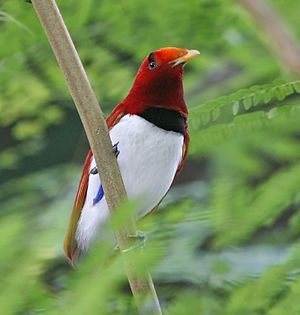King bird-of-paradise facts for kids
Quick facts for kids King bird-of-paradise |
|
|---|---|
 |
|
| Male | |
| Conservation status | |
| Scientific classification | |
| Genus: |
Cicinnurus
|
| Species: |
regius
|
| Synonyms | |
|
Paradisaea regia Linnaeus, 1758 |
|
The king bird-of-paradise (Cicinnurus regius) is a small, colorful bird. It belongs to the amazing bird-of-paradise family. This bird is often seen in the lowland forests of New Guinea. It also lives on some nearby islands. Some groups of these birds live high up in the hills.
In 1958, a person named Sten Bergman from Sweden successfully bred this bird in captivity. This was a big achievement. He even received a special medal for it.
Contents
Understanding the King Bird-of-Paradise's Name
The king bird-of-paradise was first officially described in 1758. This was done by a Swedish scientist named Carl Linnaeus. He gave it the scientific name Paradisaea regius. Today, it is the only species in the group called Cicinnurus. This group name was created in 1816 by a French bird expert, Louis Pierre Vieillot.
The name Cicinnurus comes from ancient Greek words. Kikinnos means "ringlet" or "curled lock of hair." Oura means "tail." The word regius is Latin and means "kingly." This name fits the bird well because of its royal look.
Different Types of King Bird-of-Paradise
Scientists recognize two main types, or subspecies, of the king bird-of-paradise:
- C. r. regius (Linnaeus, 1758) – This type lives in southern New Guinea. It is also found on islands west of New Guinea, like the Aru Islands.
- C. r. coccineifrons Rothschild, 1896 – This type lives in northern, central, and eastern New Guinea. It also lives on Yapen Island, which is off the northwest coast of New Guinea.
What Does the King Bird-of-Paradise Look Like?
This bird is often called a "living gem." It is the smallest and most brightly colored bird in its family.
The king bird-of-paradise is quite small. It is about 6.3 to 7.5 inches (16 to 19 cm) long. However, if you include the long tail feathers of the adult males, they can be about 12.2 inches (31 cm) long. Females usually weigh about 0.08 to 0.13 pounds (36 to 59 grams). Males are a bit heavier, weighing 0.10 to 0.14 pounds (45 to 64 grams).
Male and Female Differences
The adult male is mostly a shiny crimson red color. In some light, it can look a bit orange, especially on its head. Males have a thin, dark green band across their chest. Their lower chest is whitish. They also have cool, fan-like feathers on their shoulders with green tips. The feathers under their tail and on their back are olive-brown with shiny green tips. Their legs are violet. Their beaks are a yellowish-white color.
Female king birds-of-paradise look different. They have dull olive-colored heads and upper bodies. Their undersides are yellowish. Like the males, their legs are violet.
Where Do King Birds-of-Paradise Live?
The king bird-of-paradise lives across most of the lowland areas of New Guinea. They are also found on nearby islands. These islands include Aru, Salawati, Missol, and Yapen.
These birds mostly live in lowland rainforests. They can also be found in forests along rivers, at the edges of forests, and in areas where forests have grown back after being disturbed.
How King Birds-of-Paradise Behave
We don't know a lot about how these birds behave. They can be hard to spot. The best time to find them is when the males are showing off at their display trees.
Courtship and Reproduction
Male king birds-of-paradise are polygynous. This means one male mates with several females. The males show off by themselves or in groups in special display areas. They are very loud callers, perhaps more than any other bird-of-paradise.
Their courtship involves many things. They make complex sounds and move their feathers in special ways. They also do different body poses and movements. Sometimes, they even hang upside down and swing like a pendulum! A male's amazing courtship display includes swinging his tail. He also fluffs up his white belly feathers, making him look like a cotton ball. He performs acrobatic moves with his long tail wires.
King birds-of-paradise usually breed between March and October. The female builds a cup-shaped nest inside a tree hole. This is unique among birds-of-paradise. She lays two eggs. The female takes care of the nest and the young birds by herself. In captivity, the eggs hatched in 17 days. The young birds left the nest after 14 days.
What King Birds-of-Paradise Eat
The diet of these birds is mostly fruits and arthropods. Arthropods are creatures like insects and spiders. They look for food at all levels of the forest. They often join groups of different bird species. This helps them find arthropods in the lower parts of the forest.
Conservation Status: Are They Safe?
The number of king birds-of-paradise seems to be going down. This is because their homes are being lost. Also, too many are being hunted. However, this bird is still found in many places and is quite common. Because of this, the IUCN Red List says it is a species of "Least Concern." This means it is not currently in danger of disappearing. It is also listed in Appendix II of CITES. This means its trade is controlled to prevent it from becoming endangered.


